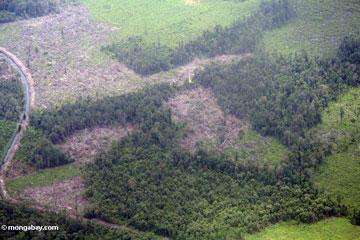Indonesia is 3rd largest greenhouse gas producer due to deforestation
Indonesia is 3rd largest greenhouse gas producer due to deforestation
mongabay.com
March 26, 2007
Indonesia trails only the United States and China in greenhouse gas emissions, reports a study released Friday by the World Bank and the British government.
Indonesia’s rank is primarily due to its high deforestation rate — about 85 percent (2,563 million tons of carbon dioxide equivalent [MtCO2e]) of its emissions (3,014 MtCO2e) result from fires and forest clearing. Emissions from energy, agriculture and waste amount to only 451 MtCO2e.
The role of peat
The report echoes findings published last year by Wetlands International and Delft Hydraulics. That study, titled Peatland degradation fuels climate change, found that emissions from the destruction of Indonesia’s extensive peat bogs alone releases 2 billion tonnes of carbon dioxide a year — about ten percent of world greenhouse gas emissions from human activities.
Each year hundreds of thousands of hectares of peatlands are drained and cleared for oil palm and timber plantations. Generally, developers dig a canal to drain the land, extract valuable timber, then clear the vegetation using fire. In dry years these fires can burn for months, contributing to the “haze” that plagues southeast Asian on a regular basis. Fires in peatlands are especially persistent, since they can continue to smolder underground for years even after surface fires on extinguished by monsoon rains.
  Indonesia had the world’s world deforestation in 2006. |
While burning releases enormous amounts of carbon dioxide, merely draining peatlands also contributes to global warming — upon exposure to air, peat rapidly oxidizes, decomposes, and releases carbon dioxide. Further carbon — about 70 percent of emissions — is released when peatlands are burned.
Beyond contributing to climate change, destruction of peatlands in Indonesia puts local populations at greater risk of flooding. Peatlands are a natural means of flood control, acting like a sponge to absorb large amounts of rainfall and runoff, while reducing the threat of erosion.
Indonesia: little success in controlling deforestation
To date Indonesia has had little success in controlling the forest fires or deforestation that contribute to its disproportionately high greenhouse gas emissions (Indonesia is world’s 22nd largest economy). Corruption and recent centralization of government has made land-policy management difficult especially with booming interest in oil palm agriculture.
In January, Indonesia said rich countries should help pay for efforts to conserve its tropical forests.
“Preserving our forest means we can’t exploit it for our economic benefits. We can’t build roads or mines,” Rachmat Witoelar, Indonesia’s minister of the environment, told Reuters. “But we make an important contribution to the world by providing oxygen. Therefore countries like Indonesia and Brazil should be compensated by developed countries for preserving their resources.”
More articles on deforestation in Indonesia
This article uses information from a Kyodo article and previous mongabay.com articles.